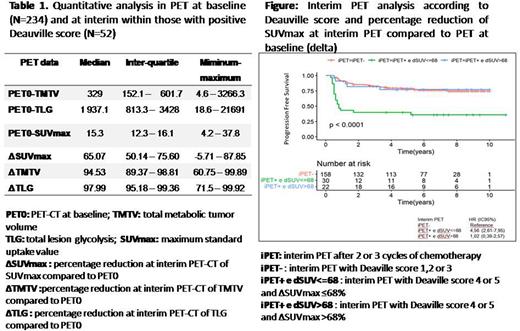Abstract
Introduction: Currently, interim PET analysis (iPET) according to the Deauville score (DS) is the most important prognostic factor used in clinical trials and clinical practice, guiding treatment decisions. However, the results of iPET studies are heterogeneous highlighting that this prognostic factor is not perfect and the need of studies trying to improve the accuracy of iPET assessment. Quantitative PET-CT analysis at baseline (PET0) and iPET with total metabolic tumor volume (TMTV) or total lesion glycolysis (TLG) has been studied as an additional predictor of progression free survival (PFS) and overall survival (OS). This study aims to evaluate the prognostic value of PET quantitative analysis (PET0/iPET) in a real-life cohort from a public oncohematology facility at the Instituto do Cancer do Estado de Sao Paulo-Brazil.
Methods: Patients (pts) from the oncohematology database with confirmed CHL diagnosis from January 2011 to December 2017, PET/CT evaluation and treated with ABVD protocol were included in this retrospective study. HIV positive pts were excluded. PET images were reviewed by two nuclear medicine physicians, blinded to the outcomes. SUVmax, TMTV, and TLG were calculated using commercial software VCAR (GE Healthcare, Waukehsa, WI, USA). Lesions were delimited by using a threshold of 41% of the maximum SUV in each lesion. TMTV and TLG at baseline were dichotomized to find an optimal cutoff value by using the method of Contal and O'Quigley. For iPET+ pts, the percentage reduction compared to PET0 (delta), ΔSUVmax, ΔTMTV and ΔTLG were calculated and also their cutoffs. Cumulative incidence of treatment failure (CIF) was estimated and death was considered a competitive event. OS and PFS were also estimated. Cox regression and regression model of Fine-Gray were used for multiple analyses.
Results: 234 pts were included in this analysis and the median follow-up was 6.8 years. The median age was 30 years old(14-79), 56% were female, 59.4% had CS III/IV, 70.5% had B symptoms, 68,3% had high-risk score (according to GHSG criteria) and 7.7% had ECOG>2. Of the 210 pts with iPET evaluation, 52 (24.7%) were positive (DS 4-5). The quantitative measures at PET0 and iPET are showed in Table 1. The OS and PFS at 5y were 85.1% and 71.1%, respectively. The CIF (5y) was 21.5% and 12% had non-disease-related death. At baseline, pts with TLG>1392.55 had higher incidence of treatment failure (HR 1.92 IC: 95% 1.05-3.51). Neither TMTV nor TLG at PET0 had an impact on PFS or OS. In multiple regression analysis (TMTV, TLG, iPET by DS, age, clinical stage), only iPET remain independent prognostic for predicting treatment failure (HR:3.70, IC95% 2.04-6.71, p< 0.001), and iPET (HR: 2.06, IC 95% 1.12-3.77, p=0.019) and age>45 (HR: 2.17, IC 95% 1.20-3.93,p=0.011) were independent predictor of PFS. In addition, better PFS was observed for those with ΔSUVmax >68.8 in iPET analysis (HR: 0.25, IC 95% 0.092-0.59, p=0.005) and for those with ΔTMTV >92.7(HR: 0.42, IC 95% 0.19-0.50, p=0.037). Cox proportional model (ΔSUVmax, ΔTMTV and ΔTLG) showed that only ΔSUVmax remain predictor of PFS (HR: 0.29, IC 95% 0.11-0.82, p=0.019). The combination of iPET+ according to DS and quantitative ΔSUVmax ≤68.8% allows identifying a group of patients with inferior PFS (Figure).
Conclusion: In a real-life cohort from developing countries, with the general profile of high-risk and high volume of tumor disease, quantitative analysis of PET0 is not predictor of PFS, OS, or CIF. However, quantitative analysis at PET0 and iPET+ (DS 4/5) together could identify a group with a worse prognosis. This information requires confirmation in prospective trials and could support future studies in iPET-guided treatment.
Disclosures
No relevant conflicts of interest to declare.
Author notes
Asterisk with author names denotes non-ASH members.


This feature is available to Subscribers Only
Sign In or Create an Account Close Modal